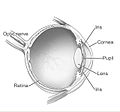Corneal neovascularization: Difference between revisions
CSV import |
CSV import |
||
| Line 48: | Line 48: | ||
{{medicine-stub}} | {{medicine-stub}} | ||
<gallery> | |||
File:Corneaneo.jpg|Corneal neovascularization | |||
File:Human_eye_diagram-sagittal_view-NEI.jpg|Sagittal view of the human eye | |||
File:Normal_Cornea_(Fig_1).tif|Normal cornea | |||
</gallery> | |||
Revision as of 03:48, 18 February 2025
Corneal Neovascularization is a pathological condition characterized by the growth of new blood vessels into the cornea, which is normally avascular. This condition can significantly compromise visual acuity and ocular health, leading to a range of visual impairments. The cornea's transparency is crucial for the refraction of light onto the retina, and the invasion of blood vessels disrupts this clarity, potentially resulting in visual disturbances or blindness.
Causes
Corneal neovascularization can be triggered by a variety of factors, including but not limited to:
- Ocular surface disease and inflammation
- Contact lens overwear or misuse
- Chemical burns to the eye
- Infectious keratitis, involving bacterial, viral, fungal, or parasitic infections
- Corneal hypoxia, or reduced oxygen supply to the cornea
- Dry eye syndrome
- Corneal graft rejection
Symptoms
Symptoms of corneal neovascularization may include:
- Redness of the eye
- Sensitivity to light (Photophobia)
- Blurred vision
- Pain or discomfort in the eye
- The feeling of a foreign body in the eye
Diagnosis
Diagnosis of corneal neovascularization involves a comprehensive eye examination, including:
- Visual acuity test
- Slit lamp examination to observe the extent and pattern of neovascularization
- Corneal topography or OCT (Optical Coherence Tomography) scans to assess the cornea's shape and thickness
- Fluorescein angiography to highlight the blood vessels
Treatment
Treatment aims to reduce the risk factors, control the underlying cause, and inhibit the growth of new blood vessels. Options include:
- Anti-VEGF therapy (Vascular Endothelial Growth Factor inhibitors), such as bevacizumab or ranibizumab, to directly target the growth of new blood vessels
- Corticosteroids to reduce inflammation
- Laser photocoagulation to cauterize and close off the vessels
- Photodynamic therapy with verteporfin
- Surgical options, such as fine needle diathermy or corneal transplantation in severe cases
Prevention
Preventive measures focus on minimizing the risk factors associated with corneal neovascularization:
- Proper use and care of contact lenses
- Timely treatment of corneal infections and injuries
- Protecting eyes from chemical exposures and UV light
- Managing dry eye syndrome and other ocular surface diseases
Prognosis
The prognosis for individuals with corneal neovascularization varies depending on the cause, extent, and response to treatment. Early detection and treatment are crucial for preserving vision and preventing permanent damage to the cornea.
-
Corneal neovascularization
-
Sagittal view of the human eye
-
Normal cornea


